

Kokino. Coordinates: Kokino - Macedonia. Kokino. Kokino garifalo by Giannis Parios & Haris Alexiou. Megalithic Temples of Malta. Location of Megalithic Temples of UNESCO World Heritage Sites within Malta Location of megalithic temples and artefacts outside UNESCO World Heritage Sites within Malta The Megalithic Temples of Malta are the eleven prehistoric monuments, of which seven are UNESCO World Heritage Sites, built during three distinct time periods between 3000 BC and 700 BC approximately.[1] They have been claimed as the oldest free-standing structures on Earth,[2] although the largely buried Göbekli Tepe complex is now believed to be older.[3][4] Archaeologists believe that these megalithic complexes are the result of local innovations in a process of cultural evolution.[5][6] This led to the building of several temples of the Ġgantija phase (3600-3000 BC), culminating in the large Tarxien temple complex, which remained in use until 2500 BC.
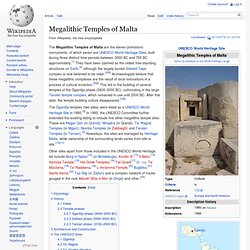
After this date, the temple building culture disappeared.[7][8] Etymology[edit] History[edit] Dates[edit] Temple phases[edit] Ġgantija phase (3000–2000 BC)[edit] Megalithic Temples of Malta. The Megalithic Temples of Malta. UNESCO has designated the main Megalithic Temples of Malta and the Hal Saflieni Hypogeum as WORLD HERITAGE SITES.
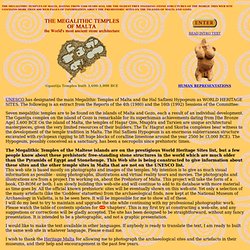
The following is an extract from the Reports of the 4th (1980) and the 16th (1992) Sessions of the Committee: Megalithic Temples of Malta. Megalithic Temples of Malta Seven megalithic temples are found on the islands of Malta and Gozo, each the result of an individual development.

The two temples of Ggantija on the island of Gozo are notable for their gigantic Bronze Age structures. On the island of Malta, the temples of Hagar Qin, Mnajdra and Tarxien are unique architectural masterpieces, given the limited resources available to their builders. The Ta'Hagrat and Skorba complexes show how the tradition of temple-building was handed down in Malta. Temples mégalithiques de Malte Les îles de Malte et de Gozo abritent sept temples mégalithiques, chacun témoignant d'un développement distinct. معابد مالطا المبنيّة من الأحجار الضخمة المستعملة في عصور ما قبل التاريخ.
Prehistoric Temples Of Malta. Of Malta left no writing behind them when they vanished, as mysteriously as they had first appeared, sometime around 2500 BC.
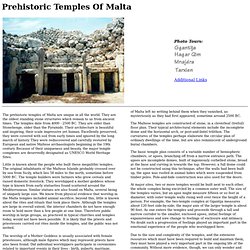
The Maltese temples are constructed of stone, in a cloverleaf (trefoil) floor plan. Their typical architectural elements include the incomplete dome and the horizontal arch, or post-and-lintel trilithon. Malta: Land of the Ancient Goddess. Hypogeum of the Volumnis Scan Data. Mnajdra. Mnajdra is a megalithic temple complex found on the southern coast of the Mediterranean island of Malta.
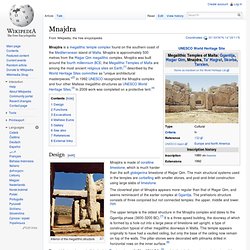
Mnajdra is approximately 500 metres from the Ħaġar Qim megalithic complex. Mnajdra was built around the fourth millennium BCE; the Megalithic Temples of Malta are among the most ancient religious sites on Earth,[1] described by the World Heritage Sites committee as "unique architectural masterpieces. "[2] In 1992 UNESCO recognized the Mnajdra complex and four other Maltese megalithic structures as UNESCO World Heritage Sites.[3] In 2009 work was completed on a protective tent.[4] Design[edit]
Mnajdra Temples - Qrendi, Malta. The Mnajdra Temples are three conjoined Neolithic temples on the southern coast of Malta. Dating from about 3000 BC, Mnajdra ("mna-ee-dra") is reminiscent of the even earlier complex at Ggantija on Gozo. Mnajdra is less than 1 km downhill from the Hagar Qim temple complex. The two complexes seem to have built at different times, and their relationship is not known. Mnajdra. Megalithic Malta 8 - Mnajdra Temples. ARCHAEOLOGY. Chichen Itza. Chichen Itza (/tʃiːˈtʃɛn iːˈtsɑː/,[1] Spanish: Chichén Itzá [tʃiˈtʃen iˈtsa], from Yucatec Maya: Chi'ch'èen Ìitsha' [tɕʰɨɪʼtɕʼeːn˧˩ iː˧˩tsʰaʲ];[2] "at the mouth of the well of the Itza") was a large pre-Columbian city built by the Maya people of the Post Classic.
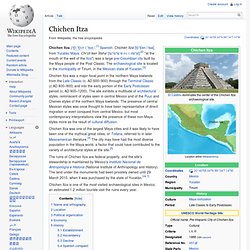
The archaeological site is located in the municipality of Tinum, in the Mexican state of Yucatán.[3] Chichen Itza was a major focal point in the northern Maya lowlands from the Late Classic (c. AD 600–900) through the Terminal Classic (c.AD 800–900) and into the early portion of the Early Postclassic period (c. AD 900–1200). Chichen Itza. Chichen Itza. Equinox at Chichen Itza. Lost Temples: Mayan Pyramids of Chichen Itza. Monte Albán. The partially excavated civic-ceremonial center of the Monte Albán site is situated atop an artificially-leveled ridge, which with an elevation of about 1,940 m (6,400 ft) above mean sea level rises some 400 m (1,300 ft) from the valley floor, in an easily defensible location.

In addition to the aforementioned monumental core, the site is characterized by several hundred artificial terraces, and a dozen clusters of mounded architecture covering the entire ridgeline and surrounding flanks (Blanton 1978). Monte Albán. Monte Alban - Archaeological Zones of Oaxaca, Mexico. Monte Alban was the ancient capital of the Zapotecs and one of the first cities in Mesoamerica.

During it's epoch, it was one of the most populated. It was founded approximately 500 years BC and flourished until 750 AD. Located in the central valley of Oaxaca, Monte Alban exercised political, economic, and ideological control over the other communities and surrounding mountains. Monte Alban. Monte Alban - The Sacred Mountain It is believed that Monte Alban was actually named in the 16th century after the Spanish landowner's surname "Montalvan".
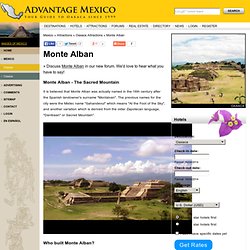
The previous names for the city were the Mixtec name "Sahandevul" which means "At the Foot of the Sky", and another variation which is derived from the older Zapotecan language, "Danibaan" or Sacred Mountain". Who built Monte Alban? What is known about the history of the region is that 4000 years ago, a village-dwelling people of unknown origin (believed by many to have been Olmec colonies) moved into the Oaxaca valleys. Then, around 500 BC (1500 years later) a new people (the Zapotecans) moved into the region. Over the years Monte Alban is known to have had contact with other cities hundreds of kilometers away: masks and sculptures reflect contact with the Maya, and architectural ideas were borrowed from Teotihuacan around 300 AD.
Monte Alban pt1. Dzibilchaltun. Temple of the Seven Dolls Sacbe at Dzibilchaltun Interior of the Temple of the Seven Dolls Cenote at Dzibilchaltun Dzibilchaltún (Yucatec: Ts'íibil Cháaltun /IPA: d̥z̥ʼiː˧˥biɭ tɕʰɒːl˦˥tuŋ/) is a Maya archaeological site in the Mexican state of Yucatán, approximately 10 miles north of state capital Mérida.
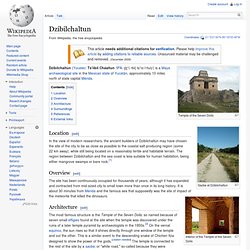
Dzibilchaltun. Dzibilchaltun Ruins - Merida - Reviews of Dzibilchaltun Ruins - Dzibilchaltun. Dzibilchaltún Dzibilchaltún was the center for salt trade since the Temple of the Seven Dolls. Dzibilchaltún was built around 200A.D. and was inhabited until the time of the Spanish Conquest. This site is home to a natural reserve, forests, cactus plants and palms.
The city was discovered around 1540 but the only excavated structure was the Temple of the Seven Dolls (Templo de las Siete Muñecas). This temple is notable because it is the only Mayan Temple with windows and a tower, instead of a roof comb. The Antiquarian Society Equinox Sunrise Dzibilchaltun Part1. The Antiquarian Society Equinox Sunrise Dzibilchaltun Part2. Teotihuacan. Coordinates: Teotihuacan /teɪˌoʊtiːwəˈkɑːn/,[1] also written Teotihuacán (Spanish teotiwa'kan ), was a pre-Columbian Mesoamerican city located in the Basin of Mexico, 30 miles (48 km) northeast of modern-day Mexico City, which is today known as the site of many of the most architecturally significant Mesoamerican pyramids built in the pre-Columbian Americas. Apart from the pyramids, Teotihuacan is also anthropologically significant for its complex, multi-family residential compounds, the Avenue of the Dead, and the small portion of its vibrant murals that have been exceptionally well-preserved.
Additionally, Teotihuacan exported a so-called "Thin Orange" pottery style and fine obsidian tools that garnered high prestige and widespread utilization throughout Mesoamerica.[2] Name[edit] This naming convention led to much confusion in the early 20th century, as scholars debated whether Teotihuacan or Tula-Hidalgo was the Tollan described by 16th–century chronicles. History[edit] Zenith[edit] Teotihuacan. Mystic Places: Teotihuacan. New Tomb at Teotihuacan. A burial chamber containing what may be the remains of a retainer of an early ruler of Teotihuacan, an ancient metropolis 30 miles northeast of Mexico City, has been found within the Pyramid of the Moon, at the northern end of the site's main thoroughfare, the Street of the Dead.
Discovered by Arizona State University (ASU) archaeologist Saburo Sugiyama, the skeleton, thought to be that of an adult male who was bound and sacrificed, was buried in a square chamber 11.3 feet on each side and five feet deep. He was surrounded by more than 150 burial offerings, including obsidian and greenstone figurines, obsidian blades and points, pyrite mirrors, conch and other shells, and the remains of eight birds (hawks or falcons) and two jaguars, which may have been buried alive. "The quality of the offerings," says Sugiyama, "is exceptional, particularly in light of the more than 1,200 burials found at the site so far.
" As veneration of the shrine grew, so did the city. Angela M.H. Share. Archeology of Teotihuacan, Mexico. Teotihuacan. Zona Arqueologica Teotihuacan. Uxmal. Uxmal (Yucatec Maya: Óoxmáal [óˑʃmáˑl]) is an ancient Maya city of the classical period in present-day Mexico. It is considered one of the most important archaeological sites of Maya culture, along with Chichen Itza in Mexico; Caracol and Xunantunich in Belize, and Tikal in Guatemala. Uxmal. Uxmal - Uxmal, Mexico. Uxmal Maya Temple. Uxmal, Mayan Pyramid of the Magician, the Yucatan, Mexico. Uxmal (Maya site in Yucatan, Mexico) Xochicalco. Xochicalco. Archaeological Monuments Zone of Xochicalco - UNESCO World Herit. Xochicalco. Xochicalco. Xochicalco "Lugar de la Casa de las Flores" Chankillo. Chankillo. Chankillo: A 2300-Year-Old Solar Observatory in Coastal Peru. Chankillo: Earliest American Solar Observatory located in Peru. Archeologists from Yale and the University of Leicester have identified an ancient solar observatory at Chankillo (alt.
The Ancient Observatory of Chankillo. CHANKILLO, Ancient solar observatory sun, PERU cult rituals. Obs. Cusco. Cusco /ˈkuːzkoʊ/, often spelled Cuzco (Spanish: Cuzco, [ˈkusko]; Quechua: Qusqu or Qosqo, IPA: [ˈqɔsqɔ]), is a city in southeastern Peru, near the Urubamba Valley of the Andes mountain range. Cusco. Cusco peru. Cusco Machupicchu. Machu Picchu. Machu Picchu (in hispanicized spelling, Spanish pronunciation: [ˈmatʃu ˈpiktʃu]) or Machu Pikchu (Quechua machu old, old person, pikchu peak; mountain or prominence with a broad base which ends in sharp peaks,[1] "old peak", pronunciation [ˈmɑtʃu ˈpixtʃu]) is a 15th-century Inca site located 2,430 metres (7,970 ft) above sea level.[2][3] It is located in the Cusco Region, Urubamba Province, Machupicchu District in Peru.[4] It is situated on a mountain ridge above the Sacred Valley which is 80 kilometres (50 mi) northwest of Cusco and through which the Urubamba River flows.
Most archaeologists believe that Machu Picchu was built as an estate for the Inca emperor Pachacuti (1438–1472). Machu Picchu. MACHU PICCHU GATEWAY,Inca trail,Hotels,Tours,Peru Vacation Trave. Machu Picchu. Michael Palin in Machu Picchu - BBC. The legendary lost city of Machu Picchu. Nazca Lines. Coordinates: Nazca Lines. The archaeology and pottery of Nazca ... Nazca Lines and Cahuachi Culture. Nazca Lines and Cahuachi Culture. Mystic Places - Nazca Lines. The Nazca Lines Mystery. Nazca lines nazca star other mysteries ... Choquequirao. Choquequirao. Choquequirao - The Cradle of Gold - Part 1. Choquequirao - The Cradle of Gold - Part 2. CHOQUEQUIRAO. Choquequirau or Choquequirao, the Machu Picchu's sacred sister. Ollantaytambo. Ollantaytambo. Living Inca City - Official Web Page. Ollantaytambo,Sacred Valley of the Incas, Cusco, Peru - A Guide. Mystic Places - Ollantaytambo. Ollantaytambo Peru 1. Ollantaytambo Peru 2.
Almendres Cromlech. Almendres Cromlech. Almendres Cromlech, Portugal. Almendres Cromlech. Arqueoturis. Arqueoturis new.